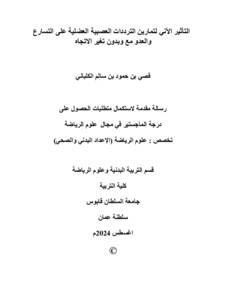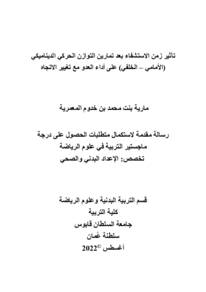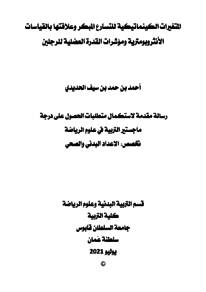Document
التأثير الآني لتمارين الترددات العصبية العضلية على التسارع والعدو مع وبدون تغير الاتجاه.
Source
رسالة ماجستير
Other titles
Acute effect of post activation potentiation using neuromuscular frequency exercises on acceleration and sprinting with and without changing of direction.
Country
عمان.
City
مسقط
Publisher
جامعة السلطان قابوس.
Gregorian
2024
Language
Arabic
Thesis Type
رسالة ماجستير
English abstract
التأثير الآني لتمارين الترددات العصبية العضلية على التسارع والعدو مع وبدون تغيير الاتجاه. هدفت الدراسة الى معرفة تأثير تمارين الترددات العصبية العضلية بمختلف أحجامها على التسارع والعدو في خط مستقيم ومع وبدون تغيير الاتجاه. تكونت عينة الدراسة من طلبة قسم التربية البدنية وعلوم الرياضة، الذكور والبالغ عددهم (18) بمتوسط أعمار (22 ± 1.8 سنة). اعتمد الباحث في هذه الدراسة على المنهج التجريبي ذو المجموعة الواحدة بالوضعيات المختلفة: الوضعية الضابطة (بدون استثارة-عضلية-عصبية) وثلاث وضعيات لتمارين الترددات العصبية العضلية مختلفة الحجم (الترددات 4 × 1 ثانية، الترددات 4 × 2 ثانية، الترددات 4 × 3 ثانية)، تم توزيع العينة بطريقة عشوائية. توصلت نتائج الدراسة الى أن تمارين الترددات العصبية العضلية تؤثر إيجاباً بمختلف أحجامها على التسارع (10 م) والعدو (30 م) في خط مستقيم (p 0.01)، وتؤثر إيجاباً بمختلف أحجامها على العدو مع تغيير الاتجاه (p 0.01) حين لا توجد فروق ذات دلالة إحصائية بين تأثيرات ثلاث أحجام من تمارين الترددات العصبية العضلية (الترددات 4 × 1 ثانية، الترددات 4 × 2 ثانية، الترددات 4 × 3 ثانية) على التسارع والعدو مع وبدون تغيير الاتجاه. وخلصت الدراسة الى أن تمارين الترددات العصبية العضلية باستخدام تمارين استثارة-العصبية-العضلية تعمل على تحسين أزمنة أداء التسارع والعدو مع وبدون تغيير الاتجاه.
Arabic abstract
Acute effect of post activation potentiation using neuromuscular frequency exercises on acceleration and sprinting with and without changing of direction. The aims of study to assess the acute effect of post-activation potentiation using neuromuscular frequency exercises (Tapping) on acceleration and sprinting, both with and without changing direction. The sample was compost of 18 male students from the Department of Physical Education and Sports Sciences at Sultan Qaboos University with an average age of (22 years ± 1.8). Methods: This study employed an experimental approach with one group under different conditions: a control condition (without neuromuscular stimulation) and three conditions involving neuromuscular frequency exercises of varying durations (Tapping 4 sec x 1, Tapping 4 sec x 2, Tapping 4 sec x 3). The sample was distributed randomly. Results the study revealed that neuromuscular frequency exercises of various durations improve affect 10-meter acceleration and 30-meter straight-line running (p < 0.01), as well as running with a change of direction, as measured by the Micodt test (p < 0.01). However, there were no statistically significant differences between the effects of the three durations of Tapping exercises on acceleration and sprinting, both with and without changes in direction. Conclusion: The post-activation potentiation using neuromuscular frequency exercises (Tapping) improves acceleration and sprint performance times, regardless of changes in direction.
Category
Theses and Dissertations




